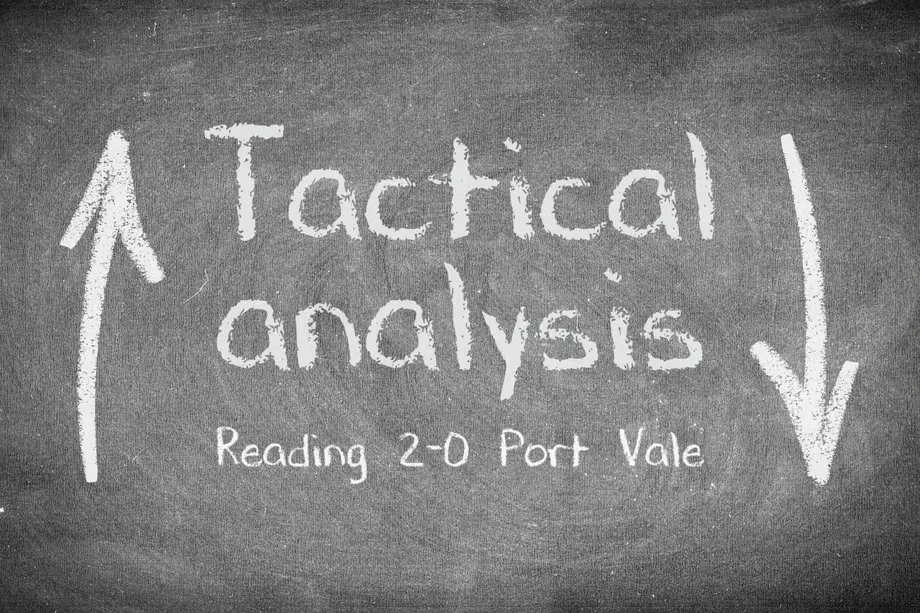
Looking back to the opposite fixture in August, the game pretty well mirrors the one that just ended. A cagey, fairly poor first half featured few open-play opportunities, but the home team turned up the heat in the second half, winning and holding strong to preserve a clean sheet.
Fortunately, we were that home team this time around, dominating the Valiants in the second half and securing our third clean sheet in as many games by the final siren.
Let’s examine Reading’s Tuesday night comeback to winning ways.
For us, the halftime substitution—which saw Michael Craig replaced by Charlie Savage—was the real game-changer. It’s not about each player’s skill set; rather, it’s just that their profiles couldn’t be more dissimilar. In my opinion, Ruben Selles realized throughout this game that starting the Welshman at the first reasonable chance was a mistake, and he did so after it became clear that we had to really take the game to Vale.
As you can see below, Craig (LDM) struggled to be the positive player who could play forward passes from deep in midfield during the first half. He didn’t get into many forward areas, and his passes lacked much menace.
In addition, his posture tended to lean left, which is the opposite direction that most of our play takes. Although Craig is more of a sweeper than a creator, using him hampered our creative midfield guys. This isn’t really Craig’s fault. This is also implied by his touch map below.
Despite Reading’s dispersed and primarily defensive play, Craig is participating in the game well, having had the second-most touches (33) of any midfielder or attacker in the first half.
Additionally, 25 of those touches were passes, demonstrating that the opposition’s quality wasn’t really dangerous enough for us to play a true number six to shield the back line because they could have kept the score clean without much midfield protection.
Let’s now examine Savage’s touch map. He was able to play much more advanced down his preferred left wing, and his return to the 4-2-3-1 really helped to even the attacking balance of play.
As you can see from the second-half positional graphic below, Lewis Wing was able to assist us build up, which was something I noted we lost in the first half when we had a deeper player on the right side.
After the interval on Tuesday, Wing produced three more deft passes, giving our deepest midfielder—Craig is not as adept at this—good choices for both long and short passes when receiving the ball from the defense.
Our overall performance on that side benefited from moving him further right as well, since our passes down important channels like Amadou Mbengue and Wing to Femi Azeez posed a greater danger.
Take note of Harvey Knibbs’ new position as well; he now plays even more forward than Sam Smith, which was helpful when the former scored his seventh goal in League One this season.
With Knibbs going forward, the previously described graphic would strongly imply a return to the 4-2-2-2 as well. I’m not entirely opposed to this, especially as it forces Smith to play on his stronger foot further to the left, where he has a much better chance of scoring than if he plays on the right, as was discussed in the Portsmouth match analysis.
Ruben Selles would have known going into the game that Port Vale is a weaker opponent than we’ve faced at the SCL recently, but the visitors’ lackluster first half performance confirmed that even more, leading to the switch to a two-man midfield with Knibbs circling the forward line.
As the screenshot below demonstrates, Savage appeared to be rotating at the left-back position during build-up, while Clinton Mola inverted, much like Wing does on the right with Andy Yiadom.
Although Savage is a better passer of the ball than Mola, it makes sense to give him more room and permission to shoot balls down the line to Smith and Kelvin Ehibhatiomhan—that is, until Mola was substituted in the 60th minute.
When in possession, Reading has adopted a formation that is nearly identical to a 3-1-3-3, with the closest full-back moving inside, Yiadom, the opposing wide defender, joining central midfield on the right, and Knibbs moving deeper on the left to support Savage’s move back and cover ground in the center of the pitch.
Again, without Craig walking to the bench, this would not have been possible.
On the other side, the same inversion occurred against Port Vale as well, with excellent results. Wing moves more in the center now, playing vertically and straight down the ground into Yiadom, who has plenty of room to turn and pass Azeez down the right wing, who finally wins a corner.
Port Vale was constantly hindered by our movement fluidity, as they were unable to keep up with marking every player as full-backs inverted.
On Saturday, we host Shrewsbury Town, who are three points behind us but still have a game in hand. Given our current form and the fact that Salop has only won once in their last seven games, this match is even more crucial to maintaining our League One status.
However, if the rematch from November is any indication, Reading may have a lower probability of winning three points than I initially believed.
Cheers to the Royals!
GET MORE NEWS HERE